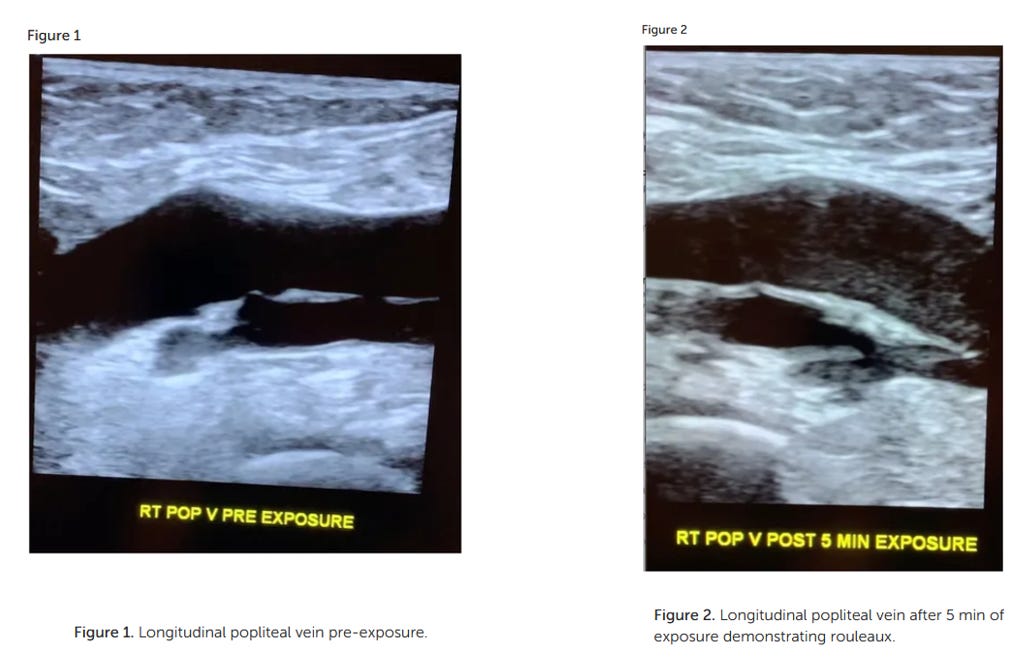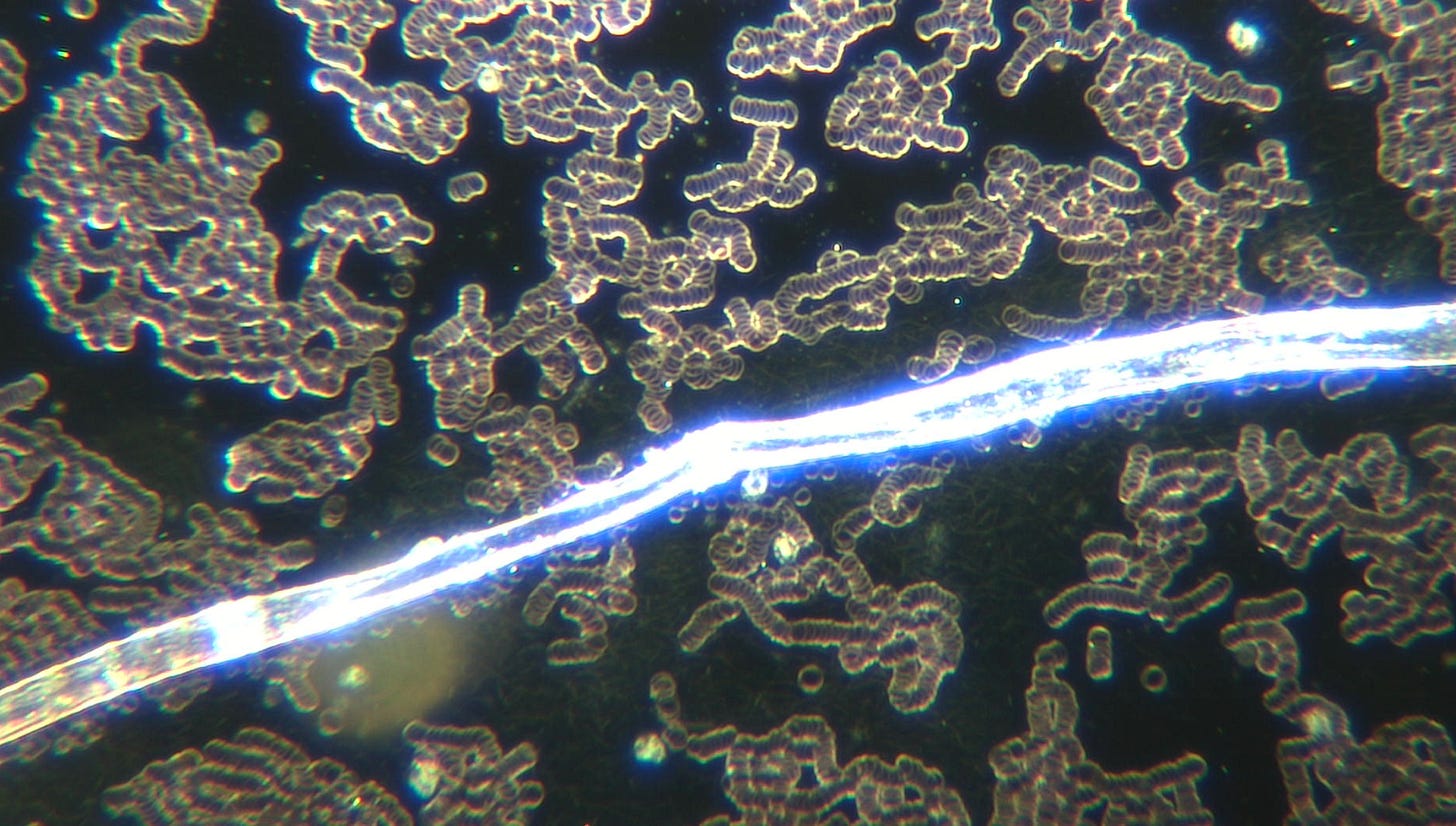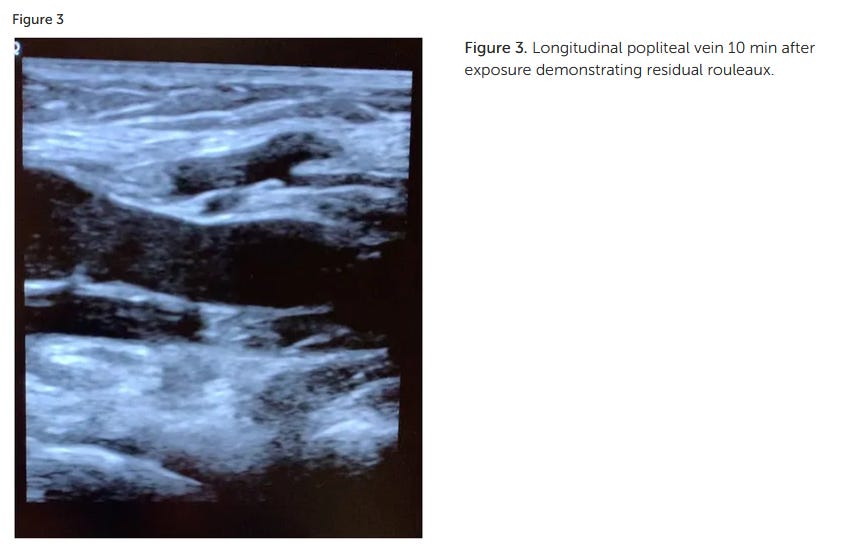Smart Phone Exposure Shows Rouleaux Formation Via Ultrasound In Large Leg Veins Within Minutes And New Guidelines For Safe Exposure For Kids To Smart Devices - Age 0-6 No Screen Time Is Safe!
Hypothesis: ultrasonography can document dynamic in vivo rouleaux formation due to mobile phone exposure
by Ana Maria Mihalcea, MD, PhD
This case report shows rouleaux formation in a leg vein after cell phone exposure via ultrasound. Live blood analysis is also a great way to show immediate rouleaux formation with exposure to smart phones. It also enhances the growth of the filaments and microchips in the blood - ultimately these blood changes increase the risk of blood clots and diminish oxygen delivery capacity of the red blood cells.
Image: COVID19 unvaccinated blood with polymer contamination after holding a cell phone. Magnification 200x. AM Medical.
Abstract:
Carrying a cellphone against the body has become commonplace in our world replete with smartphones. Acute and chronic health effects caused by these devices emitting radiofrequency radiation from multiple antennas have not been well evaluated. In this study, the popliteal vein of a healthy volunteer was imaged with ultrasonography prior to and following the placement of an idle, but active smartphone against her knee for 5 min. Pre-exposure longitudinal sonographic images demonstrate a normal anechoic lumen to the popliteal vein. Images obtained 5 min after direct skin exposure to the smartphone demonstrate a dramatic change in the acoustic appearance of the vessel. The interior of the vessel became coarsely hypoechoic with sluggish flow seen in real-time images, a typical sonographic appearance for rouleaux formation. A follow up examination performed 5 min after the subject walked around yielded continued rouleaux formation in the popliteal vein, albeit less dramatic than that observed immediately post exposure. This revolutionary in vivo method to assess radiofrequency radiation induced rouleaux formation should be further pursued in the general population to determine its prevalence and if its occurrence provides a unique biomarker of exposure that may predict morbidity.
Introduction
Researchers have reported red blood cell (RBC) aggregation, referred to as rouleaux formation, in people who have been recently exposed to electromagnetic fields and radiofrequency radiation. To date, the static technique of live blood cell analysis utilizing dark-field microscopy has been the method of choice to evaluate this phenomenon. Because this in vitro analysis may be compromised by artifact from imperfect technique, we sought to produce a novel and innovative approach to this question by devising a noninvasive, in vivo method for assessing the presence of rouleaux formation. Diagnostic ultrasound has been the preferred modality for evaluating the blood flow pattern in veins for decades. Although studies are often performed to assess for deep venous thrombosis or venous insufficiency, the presence of rouleaux formation can be readily observed. We hypothesize that ultrasonography provides a simple, non-invasive in vivo diagnostic tool to detect the presence of rouleaux formation in individuals following exposure to radiofrequency radiation.
Method
We performed a series of studies on a 62-year-old asymptomatic healthy female volunteer with no history of allergy, blood disorder, or systemic disease. The volunteer is not on any medication and her only remarkable medical history is having received a pneumococcal vaccine for a lack of pneumococcal antibodies during the previous year. She had no available blood work.
The subject was placed on a gurney and draped with her leg exposed. A GE Logic E10 ultrasound machine was utilized with an L2–9 linear probe to image the popliteal fossa. The machine has auto focus and time-gain compensation (TGCs) on a touch screen menu, which can be adjusted by the sonographer to optimize images. A senior ultrasonographer with over 25 years of experience performing vascular ultrasound identified the popliteal vein and obtained cine longitudinal images to confirm the vessel lumen was anechoic (Figure 1). Immediately following, an Apple iPhone XR smartphone operating on the AT&T mobile network was placed on the popliteal fossa for 5 min. The phone's Wi-Fi, Bluetooth, and cellular data antennas were all turned on, but the phone was otherwise inactive and idle. No calls or text messages were received during the 5-min time interval. Note however that even when a phone is not being used to make a call or send a text, devices continually update apps that require uploading and downloading from cellular networks.
Following exposure, the subject's popliteal vein was reimaged (Figure 2). No changes were made in between the two scans on the ultrasound consol. Specifically, there was no adjustment to the total gain or TGCs that could cause a change in apparent echogenicity of the popliteal structures as compared to pre-exposure images. A post exposure cine loop demonstrates abnormal heterogeneous, predominately hypoechoic material sluggishly moving to and fro within the popliteal vein and nearby tributaries. The sonographic appearance is typical for rouleaux formation, named for the histologic appearance of red blood cells when they are stacked upon one another, resembling a stack of coins. The subject experienced no symptoms.
The subject walked for 5 min after the second scan to see if the rouleaux formation would dissipate with exercise and then reimaged a 3rd time. The final imaging cine loop (10 min after exposure) demonstrate continued rouleaux formation, but the conspicuity of the aggregates had diminished as compared to the immediate post exposure images (Figure 3).
Two months after the initial study was performed, the subject returned to the ultrasound department and was reimaged utilizing the same protocol. Pre-exposure images demonstrated a normal anechoic lumen in the popliteal vein. Images obtained 5 min after cell phone exposure to the popliteal fossa again produced rouleaux formation, confirming reproducibility of the initial observation.
The subject returned 6 weeks later for a third and final assessment. During this imaging session, grey scale and duplex doppler pre-exposure images of the right and left popliteal vein were taken with the subject supine and also while standing. The pre-exposure images demonstrated a normal anechoic lumen to the popliteal veins in both lower extremities. An Apple iPhone 16 plus was then placed against the right popliteal fossa for 5 min. Following, images of the right and left popliteal veins were then obtained with the subject supine and standing. Post exposure images demonstrate rouleaux formation in both lower extremities.
I am also attaching this recent email from Professor Olle Johannson regarding the updated safe screen times for children. Please see our eye opening interview here where he explains that none of the EMF devices for cell phones work.
The enclosed very important press release from The Spanish Association of Paediatrics (AEP) is not primarily about the exposure issues to man-made electromagnetic fields, but on the use of screens in childhood and adolescence.
However, as such it can be used as a strong lever to introduce also discussions about adverse health and biological effects of these synthetic electromagnetic fields, such as from cell phone systems, WiFi, tablets, laptops, high-frequency light bulbs, wireless smart meters, baby alarms, DECT phones, powerlines, smart cities, the Internet of Things and the Internet of Bodies, 5G, 6G, 7G, and much more. They are to be viewed as a non-evolutionary-adapted form of radiation, and may therefore be labeled 'potentially toxic to life on the planet' [cf. Johansson O, "The Stockholm Declaration about "Life EMC"", Bee Culture Magazine 2022; May issue: 56-61 --- Johansson O, "Our bacteria: are they trying to tell us something?”, Newsvoice.se 20/6, 2022 --- Johansson O, "Stop! In the Name of Life!”, Newsvoice.se 9/1, 2025].
Here is the press release:
The Spanish Association of Paediatrics (AEP) updates its recommendations on the use of screens in childhood and adolescence.
Published on 05-12-2024
Madrid, 5 December 2024 - The age range below which it is considered that children should not be exposed to screens has increased from 2 to 6 years of age.
A strong association is shown between parents' screen time and their children's screen time, especially at mealtimes and in the bedroom.
It is corroborated that the excessive use of screens harms areas such as sleep, cardiovascular risk, brain volume and nutrition, among others.The Spanish Association of Paediatrics urges governments and the education system to take measures to avoid the potentially harmful effects on the health and development of children and adolescents.
With the aim of learning to use technologies in a positive way and reducing the risks involved in their inappropriate use, the Spanish Paediatrics Association (AEP), through the Digital Health working group of the Health Promotion Committee, launched the AEP's Family Digital Plan in 2023, a guide of recommendations adapted to the needs of each family and the age of the minors in it. It also drew up another document of suggestions entitled ‘Impact of digital devices on education’, which complemented the Plan. The commitment adopted by this working group was to review the content annually according to the scientific evidence accumulated over the last year. Thus, following this analysis, the new recommendations will soon be published in an article in Anales de Pediatría, the AEP's scientific journal, and on the Family Digital Plan website itself.
‘Nowadays no one doubts that digital media affect health at all levels, and at any age,’ explains Dr María Salmerón, coordinator of the AEP's Digital Health working group. ‘In 2016, the American Academy of Paediatrics warned for the first time of the impact of the digital world on health, and in recent years there has been a progressive increase in clinical trials that corroborate this link’, adds the expert.The impact of excessive screen use in childhood and adolescence is multifactorial, affecting various areas related to health and well-being, reducing quality of life.
More information in the attached press release.https://www.aeped.es/sites/default/files/20241205_ndp_aep_actualizacion_plan_digital_familiar_def.pdf [NdP_update_plan_digital_familiar_plan.pdfthe children's declaration]
'All this scientific evidence has led us to update the age-specific recommendations on the use of screens’, explains Salmerón.
0 to 6 years:
● Zero screens, there is no safe time.
● As an exception and under adult supervision, they can be used for social contact with a specific
specific objective. For example, the person on the other side of the screen can tell a story or sing a song.
a story or sing a song.
7 to 12 years:
Less than one hour (including school time and homework).
● Limit use of devices with Internet access.
● Prioritise protective factors: sporting activities, face-to-face peer relations,
contact with nature, sleep, healthy eating, etc.
● If it is decided that they should use a device, it is recommended that it be under the supervision of an adult, with fixed devices, and that
● If it is decided that they should use a device, it is advisable: under adult supervision, with fixed devices and avoiding the bathroom and bedroom.
● Agree clear limits beforehand, both in terms of time and content adapted to age.
13 to 16 years:
Less than two hours (including school time and homework).
● If access to devices is allowed - but not the only measure to be taken - install parental control tools.Olle Johansson, associate professor
Go paid at the $5 a month level, and we will send you both the PDF and e-Pub versions of “Government” - The Biggest Scam in History… Exposed! and a coupon code for 10% off anything in the Government-Scam.com/Store.
Go paid at the $50 a year level, and we will send you a free paperback edition of Etienne’s book “Government” - The Biggest Scam in History… Exposed! OR a 64GB Liberator flash drive if you live in the US. If you are international, we will give you a $10 credit towards shipping if you agree to pay the remainder.
Support us at the $250 Founding Member Level and get a signed high-resolution hardcover of “Government” + Liberator flash drive + Larken Rose’s The Most Dangerous Superstition + Art of Liberty Foundation Stickers delivered anywhere in the world. Our only option for signed copies besides catching Etienne @ an event.









And parents don't even give kids blue blockers, like wth? I'm old enough that we were told to sit back from the TV because of the radiation. My Dad wouldn't even own a TV so that probably helped me be more awake. I'm going to get the Above Phone... not sure if you've heard of that? The Creator says they even store theirs in the microwave at night, etc, because it blocks the emfs. Which apparently, is also why they wanted lead paint removed.. because it blocks them as well.
My curious mind wonders whether the researchers tested the effects of the ultrasound scanner itself on the patient. I assume that the high-frequency sound is created by an electro-mechanical transducer in a way similar to audible sound from a speaker. It's easy to measure the magnetic flux density from a speaker with an EMF meter. I wonder what the frequency and intensity is of the magnetic field from the ultrasound transducer which is place in direct contact with the skin of the patient. When I think of the routine use of ultrasound scans of pregnant women it concerns me a bit. Does anyone have access to research on this?